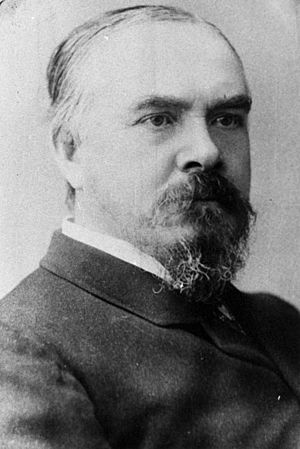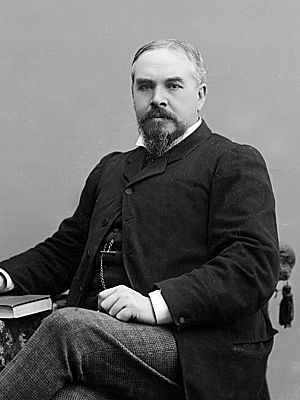John Ballance facts for kids
Quick facts for kids
John Ballance
|
|
|---|---|

Ballance c. 1880
|
|
| 14th Premier of New Zealand | |
| In office 24 January 1891 – 27 April 1893† |
|
| Monarch | Victoria |
| Governor | William Onslow David Boyle |
| Preceded by | Harry Atkinson |
| Succeeded by | Richard Seddon |
| 1st Leader of the Opposition | |
| In office 2 July 1889 – 23 January 1891 |
|
| Deputy | Richard Seddon |
| Succeeded by | John Bryce |
| 17th Minister of Lands | |
| In office 3 September 1884 – 8 October 1887 |
|
| Prime Minister | Robert Stout |
| Preceded by | Richmond Hursthouse |
| Succeeded by | George Richardson |
| 5th Minister of Defence | |
| In office 16 July 1884 – 8 October 1887 |
|
| Prime Minister | Robert Stout |
| Preceded by | John Bryce |
| Succeeded by | Thomas Fergus |
| 1st Minister of Education | |
| In office 12 January 1878 – 1 July 1879 |
|
| Prime Minister | George Grey |
| Succeeded by | William Rolleston |
| Member of the New Zealand Parliament for Wanganui |
|
| In office 22 July 1884 – 27 April 1893 |
|
| Preceded by | William Hogg Watt |
| Succeeded by | Archibald Willis |
| In office 5 September 1879 – 9 December 1881 |
|
| Preceded by | William Fox |
| Succeeded by | William Hogg Watt |
| Member of the New Zealand Parliament for Rangitikei |
|
| In office 24 April 1875 – 5 September 1879 |
|
| Preceded by | William Fox |
| Succeeded by | William Willis |
| Personal details | |
| Born | 27 March 1839 Glenavy, Ulster, Ireland |
| Died | 27 April 1893 (aged 54) Wellington, New Zealand |
| Political party | Liberal |
| Spouses | Fanny Taylor (m. 1863, d. 1868) Ellen Anderson (m. 1870) |
| Children | 1 (adopted) |
| Parents | Samuel Ballance Mary McNiece |
| Awards | New Zealand Medal |
| Signature | |
| Military service | |
| Allegiance | New Zealand Army |
| Years of service | 1868–69 |
| Rank | |
| Battles/wars | New Zealand Wars |
John Ballance (27 March 1839 – 27 April 1893) was an important politician in New Zealand. He was born in Ireland and became the 14th Premier of New Zealand, which is like being the Prime Minister. He served from January 1891 until he passed away in April 1893.
John Ballance also started New Zealand's first organized political group, the Liberal Party. He led this party to win the election in 1890. This was the first time a New Zealand government was formed based on political parties. He believed in giving women the right to vote and wanted to make land ownership fairer.
Contents
Early Life and Moving to New Zealand
John Ballance was born on March 27, 1839, in Glenavy, Ireland. He was the oldest son of Samuel Ballance, a farmer, and Mary McNiece. He went to a national school and then learned to be an ironmonger, someone who sells metal goods.
Later, he worked as a clerk in a metal goods company in Birmingham, England, where he got married. John loved reading books and spent a lot of time doing so. He also became very interested in politics, influenced by his parents. His mother, who was a liberal, gave him many of the ideas he would later support.
In 1866, John and his wife moved to New Zealand. They planned to open a small jewelry business. However, when they settled in Wanganui, he decided to start a newspaper called The Wanganui Herald. He became the editor and owned the newspaper for the rest of his life.
During a conflict with the Māori chief Titokowaru in 1867, John joined a volunteer cavalry group. He was given a special rank, but he lost it because his newspaper published articles that criticized how the fighting was being managed. Even so, he was recognized for his bravery and received the New Zealand Medal.
After the conflict, John Ballance became more respected in Wanganui. People admired how he managed the Herald and his honest reporting. He got involved in many town activities, even starting a chess club, where he became a skilled player. In 1868, his wife Fanny died at age 24. Two years later, he married Ellen Anderson.
Becoming a Member of Parliament
| New Zealand Parliament | ||||
| Years | Term | Electorate | Party | |
| 1875–1876 | 5th | Rangitikei | Independent | |
| 1876–1879 | 6th | Rangitikei | Independent | |
| 1879–1881 | 7th | Wanganui | Independent | |
| 1884–1887 | 9th | Wanganui | Independent | |
| 1887–1890 | 10th | Wanganui | Independent | |
| 1890–1893 | 11th | Wanganui | Liberal | |
John Ballance first thought about becoming a national politician in 1872. He put his name forward for a special election in the Egmont area. However, he decided not to run before the voting happened.
In 1875, John Ballance officially joined the Parliament. He won a special election for the Rangitikei area. He focused on two main ideas: getting rid of the provinces (smaller local governments) and making education free for everyone. He quickly made an impact in Wellington.
The provinces were removed in 1876. After that, John Ballance focused on helping more people settle on land. He believed this was the most important issue for the country at the time.
Working with Sir George Grey
In 1877, John Ballance joined the government of Sir George Grey, who was the Premier (leader). Even though Grey's ideas were not exactly the same as his, Ballance believed he could still do good work. He became the Minister of Customs, Minister of Education, and later the Colonial Treasurer. It was a surprise to many that a relatively new politician was given such an important job.
In 1878, Ballance presented a major financial plan. He changed the tax system by removing taxes on basic goods. He also introduced a small land tax, an idea he would use again later. However, his partnership with Grey ended with a big disagreement. Ballance felt Grey was too controlling and bossy. He resigned from his roles but still supported Grey in Parliament.
From 1879, Ballance represented the Wanganui area in Parliament. But in 1881, he lost the election by only four votes. He returned to Parliament for Wanganui in 1884.
Working with Robert Stout
When he was re-elected in 1884, John Ballance became a minister in the government of Robert Stout, who was also a liberal thinker. Ballance was the Minister of Lands and Immigration, Minister of Defence, and Minister of Native Affairs (which dealt with relations with Māori people).
As Minister of Lands, he encouraged people to settle in rural areas. He wanted more people to leave cities and "work the land." He believed this was important for New Zealand to produce more goods and become more self-sufficient. His plan of "village settlements" was quite successful. This plan involved the government leasing small pieces of land to farmers and lending them money to start building and farming.
Even though he wanted more settlers, he strongly supported the rights of Māori people to keep their land. Many other politicians at the time thought that taking Māori land was necessary for more settlement. He reduced the number of soldiers in areas where there were tensions with Māori. He also tried to learn about Māori language and culture.
In 1887, Stout's government lost the general election. However, John Ballance remained popular. He became ill, which stopped him from fully participating in politics for a while. But after he recovered in July 1889, he became the Leader of the Opposition. This meant he was the main leader of the political group not in power.
Becoming Premier of New Zealand

In 1890, John Ballance led a group of liberal politicians to win the general election. People were unhappy with the government at the time, and there were strikes and economic problems. So, more liberal candidates did well in the election.
Harry Atkinson, the Premier who had defeated Stout, had to resign. But before he left, he appointed many of his supporters to the Legislative Council. This was a problem for Ballance's new government. However, Ballance managed to fix it by changing the rules so that members of the Legislative Council only served for seven years instead of for life. His success in dealing with the Governor over these changes helped define the relationship between the elected Premier and the appointed Governor, giving more power to the Premier.
John Ballance strongly supported women's suffrage, which means giving women the right to vote. He told Parliament that he believed in "absolute equality of the sexes." This idea was also supported by his political wife, Ellen, and his colleague Julius Vogel.
In 1891, Ballance also introduced new taxes: a progressive land tax and a progressive income tax. A progressive tax means people with more land or higher incomes pay a higher percentage in tax. He was praised for how he managed the economy, which grew a lot during his time as Premier.
The First Liberal Government
As the leader of the liberal group in Parliament, John Ballance brought his allies together to form the Liberal Party. This was New Zealand's first official political party. It was created to represent the liberal ideas of Ballance, Stout, and Vogel.
The next four Premiers after Ballance were also from the Liberal Party. However, some of them, like Richard Seddon, did not always follow the ideals that Ballance had set out. John Ballance was known for being quiet and humble. He seemed to prefer his books and chess games over public events. People described him as "unassuming and unpretentious," and he was polite and very patient.
Ballance carefully chose talented people for his government. He led the government through two challenging years of economic changes. He made himself the Treasurer and introduced new land and income taxes. These taxes were similar to those under Grey but were more significant.
His government also passed other important laws, like the Land Act 1892 and the Land for Settlements Act 1892. Even though there was some initial disagreement, people eventually saw the taxes as fair. Many people found themselves better off because direct taxes were greatly reduced.
Death and Legacy
In 1893, when he was very successful and popular, John Ballance became ill with an intestinal disease. He died in Wellington after a major surgery. He was the first New Zealand Prime Minister to die while still in office.
It is believed that he wanted Robert Stout to take over as Premier after him. However, his illness came on quickly, and he couldn't make sure that happened. So, Richard Seddon became the next Premier.
A statue was built to honor him in front of the Parliament House in Wellington. It stands in front of what is now the parliamentary library. Another statue was put up in Moutoa Gardens in Wanganui.
See also
 In Spanish: John Ballance para niños
In Spanish: John Ballance para niños




